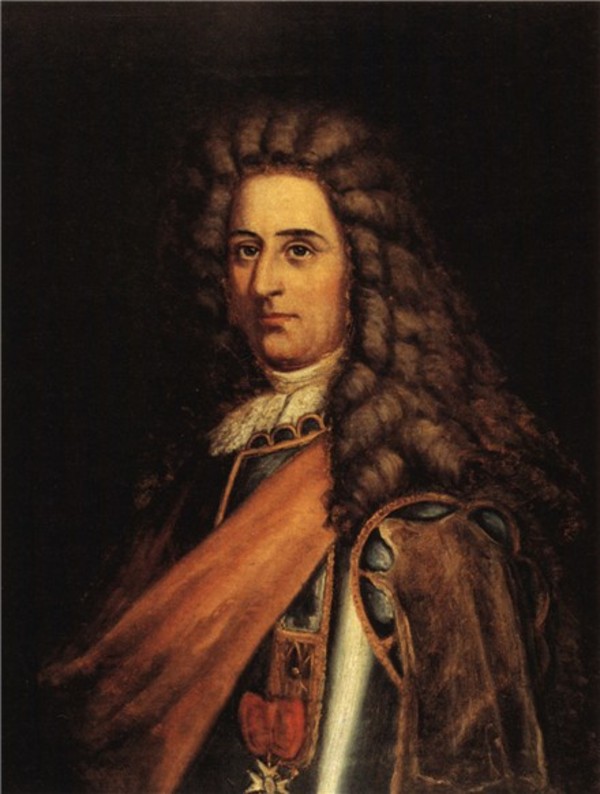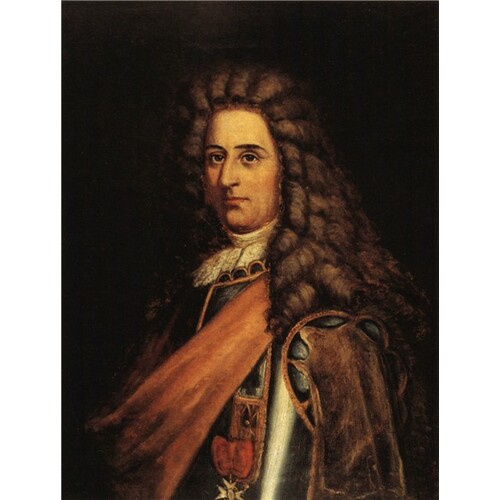
Source: Link
TESTARD DE MONTIGNY, JACQUES, officer in the colonial regular troops in Canada, famous for his campaigns in Newfoundland, son of Jacques Testard de La Forest and Marie Pournin; b. 1663 at Montreal, d. there in 1737.
The Testards were a family of Montreal merchants connected by marriage with the Le Moynes and the Le Bers. Orphaned at an early age, Jacques and his elder brother Gabriel Testard* de La Forest were brought up by their step-father Jacques de La Marque, whose name the younger brother seems to have borne at certain times. Jacques Testard de Montigny took part as a volunteer with the colonial regular troops in the expedition launched by Buade* de Frontenac in the direction of Fort Orange (Albany, N.Y.) and in the sacking of Corlaer (Schenectady, N.Y.). He travelled to France in 1692 on board one of Pierre Le Moyne d’Iberville’s ships, and was still there when the governor received the order to reinforce the garrison of Fort Nashwaak (Naxouat) on the Saint John River, where Robinau* de Villebon was in command. A company was assigned to Lieutenant Claude-Sébastien de Villieu; Montigny, who had become an ensign with the colonial regular troops, served in this company as lieutenant. The two officers took up their post on 25 Nov. 1693, and they both applied themselves successfully to the task of leading detachments of Abenakis to harass the English settlers. Each of them participated in commerce and fur-trading, and this gave rise to conflicts of interest between the commandant and the Damours brothers (Mathieu. Damours* de Freneuse, Louis and René Damours), who held large land grants in the region and with whom Montigny and Villieu were associated. In 1695, the latter had to come to Quebec to explain their conduct and promise to observe regulations more closely.
The following year, before launching his great offensive in Newfoundland, Iberville landed in Acadia; his mission was to destroy Fort Pemaquid (Fort William Henry), which the English had rebuilt at the mouth of the Kennebec River. Montigny was to support him in Acadia and then to join the Newfoundland expedition. He set off in the advance guard and neutralized some small forts which could have given the alarm, after which the combined forces of the ships and the Abenakis, who were led by Saint-Castin [Jean-Vincent d’Abbadie], readily secured the capitulation of Pemaquid. The Newfoundland campaign opened at the beginning of the winter. Montigny, experienced in all the tactics of forest fighting with the Indians, gave valuable help; this is stressed by Abbé Baudoin* who left an accurate account of the campaign. The main body of the troops, led by Iberville and Governor Jacques-François de Brouillan [Monbeton], seized St John’s on 30 Nov. 1696, set fire to the place, then returned to Placentia (Plaisance), where they got rid of the prisoners and divided up the booty. Iberville placed a detachment under Montigny, with the order to clear the English coastal area of all its establishments. Apart from St John’s, which was only a village, there was nothing but some scattered fishermen’s settlements and a few little clusters of storehouses at the innermost point of the harbours. Wearing snowshoes, the French went from house to house, taking prisoner those who could not flee in time, seizing the belongings which were not hidden in the woods, emptying the warehouses and storehouses of cod, and setting fire to the boats. At the end of March the English retained only Bonavista and Carbonear Island, and their fisheries were ruined.
Iberville left Newfoundland without being able to consolidate his gains there, and Montigny went back to Canada, where on 20 April 1700 he received his appointment as lieutenant. Four years later Rigaud de Vaudreuil sent him back to Acadia, where he conducted a few raids on the English establishments and worked actively at persuading the Abenakis to leave this overexposed region and come to settle in Canada.
Iberville’s conquest had been short-lived, and the English very quickly reorganized their establishments in Newfoundland [see Gibsone]. Consequently in 1705 Auger de Subercase undertook a second campaign, in which Montigny again took part. This time it is he who has left us the account (5 March–6 June 1705) of this expedition, which was conducted with as much dash as the first. After raising the siege of St John’s [see Moody] with the able help of François Picoté de Belestre and Étienne de Villedonné, he sent forces through the woods and by sea to gather up and disarm all the settlers along the coasts. In the deserted harbours, the houses, boats, and drying-platforms were set on fire, and the salt was thrown into the sea. Hearing that Montigny was conducting this campaign, Bonavista, following George Skeffington’s advice, agreed to capitulate. The victory was complete, but it was to have no more consequences than the first one.
The next year Montigny went to France to present to the king and the court the Abenaki chief Nescambiouit, who had served with distinction at his side in the two Newfoundland campaigns. As a captain on the active list as of 23 June 1706, Montigny resumed his service in Canada and assisted Ramezay in the 1709 expedition to Pointe-à-la-Chevelure (Scalping Point). He remained attached until the end of the war to the army that Vaudreuil maintained to the south of Montreal to repel Nicholson’s invasion. In 1712 he received the cross of the order of Saint-Louis, and the following year he was granted leave, to recover his health. In 1718, having been left a widower from his first marriage, contracted in 1698 with Marguerite Damours, he married the young Marie-Anne de La Porte de Louvigny, who bore him seven children. His family was established at Montreal, and probably Montigny served in a garrison on the island or in the neighbourhood. On two further occasions, however, despite his advanced age he was sent to distant posts, being “feared and respected by the Indians.”
In 1721 Vaudreuil put him in command of Baie des Puants (Green Bay). On his way through Michilimackinac to take up his post, he met Charlevoix*, and they travelled down to the bay together. During this journey Montigny talked to the Jesuit about the outstanding achievements of his career, and the latter recorded them later in his Histoire de la Nouvelle-France. There was nothing remarkable about the officer’s stay at the bay except a council held with the Foxes in September 1722. The following year Nescambiouit, who had been living among the Foxes since 1716, returned to the Saint-François mission, perhaps at Montigny’s urging, for the latter assured the authorities of the unswerving loyalty of the Abenaki chief, who had for a moment been suspected of treason. In the autumn of 1723 Montigny was back at Montreal, but in 1730 he went up again to Michilimackinac to take over from the commandant, Renaud Dubuisson. He was placed on half pay in 1733, and died on 9 July 1737 at Montreal. The governor and the intendant invoked his distinguished services in order to obtain a pension for his widow, who was left without means of support.
AN, Col., B, 16, 19, 22, 27, 29, 34, 35, 44, 45, 47, 48, 50, 52–55, 57, 58; C11A, 29, 32, 33, 42–67; C11D, 2, 3, 4; D2C, sur fiches (états de service des officiers); Marine, C7, 217 (dossier de Montigny). Charlevoix, Histoire. “Correspondance de Frontenac (1689–99),” APQ Rapport, 1927–28, 1928–29. “L’expédition de M. de Montigny à Terreneuve en 1705,” APQ Rapport, 1922–23, 293–98. Journal de l’abbé Beaudoin (Gosselin). Tanguay, Dictionnaire. Frégault, Iberville.
Cite This Article
Louise Dechêne, “TESTARD DE MONTIGNY, JACQUES,” in Dictionary of Canadian Biography, vol. 2, University of Toronto/Université Laval, 2003–, accessed January 19, 2026, https://www.biographi.ca/en/bio/testard_de_montigny_jacques_2E.html.
The citation above shows the format for footnotes and endnotes according to the Chicago manual of style (16th edition). Information to be used in other citation formats:
| Permalink: | https://www.biographi.ca/en/bio/testard_de_montigny_jacques_2E.html |
| Author of Article: | Louise Dechêne |
| Title of Article: | TESTARD DE MONTIGNY, JACQUES |
| Publication Name: | Dictionary of Canadian Biography, vol. 2 |
| Publisher: | University of Toronto/Université Laval |
| Year of publication: | 1969 |
| Year of revision: | 1982 |
| Access Date: | January 19, 2026 |



